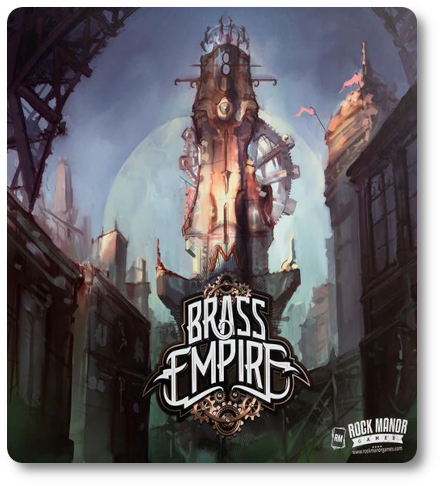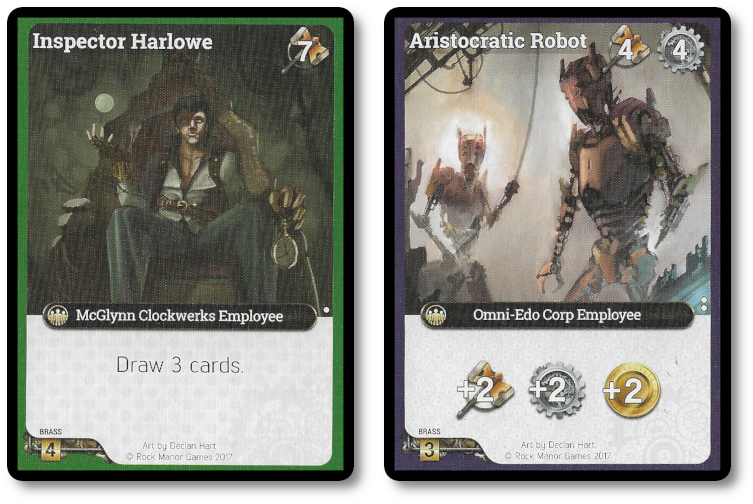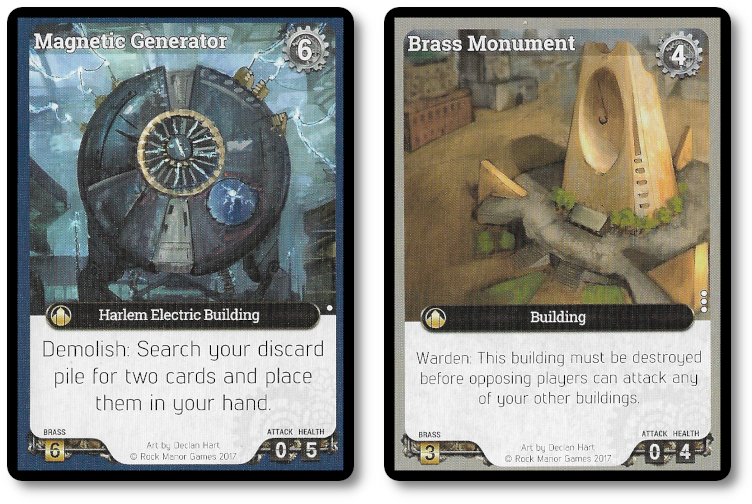 The Basics:
The Basics:
- For ages 10 and up (publisher suggests 14+)
- For 1 to 5 players
- Approximately 60 minutes to complete
Geek Skills:
- Active Listening & Communication
- Counting & Math
- Logical & Critical Decision Making
- Reading
- Strategy & Tactics
- Risk vs. Reward
- Hand/Resource Management
Learning Curve:
- Child – Moderate
- Adult – Easy
Theme & Narrative:
- Conquer your competition through might and finance
Endorsements:
- Gamer Geek approved!
- Parent Geek approved!
- Child Geek approved!
Overview
French judge, man of letters, historian, and political philosopher, who went simply as Montesquieu, said, “An empire founded by war has to maintain itself by war.” In this game, the war you wage is one of commerce and finance, building corporations into financial empires through subterfuge, hostile takeovers, and flat-out destroying the infrastructure of your competition. All of this, mind you, is set in a world where steam power rules and science fiction is a reality. Tighten your cufflinks, holster your Tesla pistol, and sheath your Samurai sword; it’s time to go to work.
Brass Empire, designed by Mike Gnade and published by Rock Manor Games, is comprised of 55 Starting cards, five Corporation Reserve decks (for a total of 30 cards), 100 Labor Pool cards, 90 Design Pool cards, 50 Brass tokens (in the point values of one and five), and ten standard six-sided dice. The game component quality is excellent, with durable cards and solid cardboard tokens. Artist Declan Hart brilliantly portrays a gritty and steampunk-inspired profit-driven world through his illustrations that further reinforce the game’s theme and narrative.
Getting Ready for Monday
To set up the game, complete the following steps:
First, give each player their starting deck of 11 cards. Each player starts with the same number and type of cards. From this starting deck, have each player find and place face-up in front of them the “Minning Platform.” All other cards should be shuffled and placed face-down in front of them. This is the player’s draw deck for the duration of the game.
Second, have each player select a Corporation faction to represent. Each Corporation is different and provides unique playing styles on the road to victory. Some are also more aggressive than others, while some corporations take their time building up their steam. There are five Corporations to select from.
- Windcraft Enterprises
- Frontier Rail
- Harlem Electric
- Omin-Edo Corp
- McGlynn Clockwerks
Once the player selects the Corporation of their choice, they take the six recommended Reserve cards associated with that faction. These are placed face-up in a stack and off to one side of the player’s area. This special reserve is only available to the player to purchase.
Third, take all Building and Unit cards, shuffle them, and place them face-down to create the Design draw deck.
Fourth, take all the Employee cards, shuffle them, and place them face-down to create the Labor draw deck.
Fifth, place six cards from the Design and the Labor deck in a row, face-up. The row of cards from the Design deck is called the “Design Department.” The row of cards from the Labor deck is called the “Labor Market.” Very clever.
Sixth, place a specified number of Brass tokens together and off to one side of the game-playing area. This is called the “Mining Pool,” from which both players will take. The number of Brass tokens used is up to the players, as the total number in the game determines the length of the gameplay.
That’s it for the game setup. Determine which player should go first and begin. But before doing so, have each player draw five cards from their draw deck to create their starting hand.
The Corporate Grind
Brass Empire is played in turns and rounds with no set number of turns per game. A player’s turn is summarized here.
Step One: Reset Buildings
“Building” cards represent permanent structures previously built by the player that provide to that player certain benefits. When “Building” cards first come into play, they are placed face-down, representing that they are being built. When the player starts their turn, any “Building” cards face-down are now completed and provide the player their special benefit.
Step Two: Play Cards
This step of the player’s turn is best completed by completing the following sequentially.
First, play Employee cards to provide the player with Labor and Construction. These are two significant resources necessary to build and grow their corporate empire. Use these values to buy cards from the “Design Department” and the “Labor Market.” The player can buy as many cards as they like if they have the right resources to pay for them. Players may also purchase those cards set aside at the start of the game from their private reserve. As soon as any card leaves the “Design Department” or “Labor Market” row, replace it before continuing to purchase any other cards. All purchased cards go to the player’s discard pile.

Second, play any “Unit” cards from your hand, face-up, and in front of you. They cannot attack other units during your turn but can be attacked by other units from your opponents. I suggest you tip them slightly, visually giving you a clue that they are now available but not active. Play “Building” cards now, too, but place them face-down. You’ll be able to flip those over during your next turn. Buildings in the process of being built cannot be targeted for an attack.
Note that some cards have special abilities that trigger once they are played. Drawing new cards or collecting Brass tokens. If cards played do have these, announce the action and then resolve. Do this for every card as it comes into play.
Step Three: Take Actions
The player may now act with the cards in play that were activated this or during a previous round.
“Unit” cards may attack other units. Each unit has an attack and a health value. The attack determines the amount of health the target of the attack suffers. If a “Unit” card’s health is ever reduced to zero or less, they are discarded. It is important to note that all “Unit” cards attack back when attacked, meaning all damage and health reduction is done simultaneously. This means it is possible that two “Unit” cards can remove themselves from the table and into their owner’s discard pile.

“Building” cards that are active may also be used. Note that some “Building” cards require they be discarded to provide their benefit. Some “Building” cards can also be attacked, and most can be damaged.

The “Minning Platform” is the only building available to the player that does not get discarded if it is destroyed. Instead, the card is flipped over and becomes available during the player’s next turn.

Step Four: Ending Turn
After the player has completed all the actions they want or are capable of, they announce their turn is over. All played “Employee” cards are placed in the discard pile, and any cards still in the player’s hand are discarded, too. “Unit” and “Building” cards remain in play until destroyed.
The player now draws five new cards. If they cannot draw five, they draw as many as they can, shuffle their discard pile, place it face-down to become their new draw deck, and continue to draw cards until they have a total of five.
This completes the player’s turn. The next player takes their turn, as summarized above. When all the players have had a turn, a round is completed, and a new round begins.
TGIF and Victory
The game continues with players building more powerful structures, reinforcing their corporate strength with unit might, and capturing as much Brass as possible. The game ends when the Brass tokens are removed from the “Minning Pool.” The current round is completed, ensuring all players have the same number of turns. It is possible still to earn Brass during the player’s last turns. Track this additional Brass with any tokens not currently used or through other means.
Players now count up the total number of Brass they are worth. This is done by counting acquired Brass tokens and the Brass value found on the cards the player acquired during the game. The total Brass counted is the player’s score. The player with the highest score wins the game.
Game Variants
There are several different ways to play the base game if so desired.
- Customize the Company Reserve decks to create unique possibilities as the game progresses.
- Have players build their own starting Corporation decks.
- Play as a team to win together.
- Battle it out by using Brass tokens as victory tokens to be won by defeating your opponents.
- Go solo and test your gaming skills against a built-in AI.
To learn more about Brass Empire, visit the games’ webpage.
Final Word
 The Child Geeks had no issues learning how to play this game but did request parental and older sibling input when the rules were in question. Some cards use language that requires rules that are not readily obvious. No problems, however, as the rule book does an excellent job of clarifying. The games were cutthroat, but never to a point where any of the Child Geeks felt bullied or specifically targeted. They were, however, nonetheless frustrated. According to one Child Geek, “The most frustrating thing about this game is not being able to buy what I want and keep it in play for as long as I like.” Another Child Geek said, “I like the game, and I liked playing it with my dad the best because I felt he let me explore it more while my older brother just beat me up until he won.” When all the games were over – regardless of whether they won or lost – all the Child Geeks gave the game their full approval, finding the gameplay fast and fun and the game’s theme to be of great interest.
The Child Geeks had no issues learning how to play this game but did request parental and older sibling input when the rules were in question. Some cards use language that requires rules that are not readily obvious. No problems, however, as the rule book does an excellent job of clarifying. The games were cutthroat, but never to a point where any of the Child Geeks felt bullied or specifically targeted. They were, however, nonetheless frustrated. According to one Child Geek, “The most frustrating thing about this game is not being able to buy what I want and keep it in play for as long as I like.” Another Child Geek said, “I like the game, and I liked playing it with my dad the best because I felt he let me explore it more while my older brother just beat me up until he won.” When all the games were over – regardless of whether they won or lost – all the Child Geeks gave the game their full approval, finding the gameplay fast and fun and the game’s theme to be of great interest.
 The Parent Geeks were impressed with how fast the game was set up and how quickly it was played. For a few, the game was a bit too fast and a bit too brutal. According to one Parent Geek, “I like the game. I’m not saying I don’t. I need games like this at my table that teach me to think fast and take a hit. This is not a game I would recommend to a new player who has a soft ego.” Another Parent Geek said, “The game can be fun, but you must be careful who you play with. I played it with my 10-year-old, and she became very frustrated. In contrast, I played the same game with my 14-year-old, and she loved it. Remember that the game requires you to be active and aggressive.” The Parent Geeks agreed on two important points when the last corporation was bought and sold. First, Brass Empire was a game they enjoyed. Second, it is a game you need to play with other gamers who like aggressive games. Not necessarily for the family as a whole.
The Parent Geeks were impressed with how fast the game was set up and how quickly it was played. For a few, the game was a bit too fast and a bit too brutal. According to one Parent Geek, “I like the game. I’m not saying I don’t. I need games like this at my table that teach me to think fast and take a hit. This is not a game I would recommend to a new player who has a soft ego.” Another Parent Geek said, “The game can be fun, but you must be careful who you play with. I played it with my 10-year-old, and she became very frustrated. In contrast, I played the same game with my 14-year-old, and she loved it. Remember that the game requires you to be active and aggressive.” The Parent Geeks agreed on two important points when the last corporation was bought and sold. First, Brass Empire was a game they enjoyed. Second, it is a game you need to play with other gamers who like aggressive games. Not necessarily for the family as a whole.
 The Gamer Geeks found the theme and the game to be fairly “meh” regarding introducing anything new. Our Gamer Geek elitists have played many games over many years, and they didn’t see anything unique or exciting about the game. They very much enjoyed the gameplay, however. As one Gamer Geek put it, “The game is well designed, benefiting from years upon years of other games like this blazing the trail, but it is also very streamlined. There is no room for anything other than bringing your full attention and energy to the game. I liked it.” Another Gamer Geek said, “Surprisingly brutal and aggressive, but the game was also very streamlined and easy to learn, fast to play, and quickly tickled my fancy. I’d play this again.” When the very hostile corporate takeovers were complete, the Gamer Geeks took a vote and all greed that Brass Empire was worth investing in.
The Gamer Geeks found the theme and the game to be fairly “meh” regarding introducing anything new. Our Gamer Geek elitists have played many games over many years, and they didn’t see anything unique or exciting about the game. They very much enjoyed the gameplay, however. As one Gamer Geek put it, “The game is well designed, benefiting from years upon years of other games like this blazing the trail, but it is also very streamlined. There is no room for anything other than bringing your full attention and energy to the game. I liked it.” Another Gamer Geek said, “Surprisingly brutal and aggressive, but the game was also very streamlined and easy to learn, fast to play, and quickly tickled my fancy. I’d play this again.” When the very hostile corporate takeovers were complete, the Gamer Geeks took a vote and all greed that Brass Empire was worth investing in.
 Brass Empire was a lot of fun. The game is very streamlined and has taken out a lot of “fluff” that would otherwise bog the game down. For example, the card plays on a person’s turn are meant to be quick, to the point, and definitive. You play your cards, take your actions, and clean up your stuff. Done. Finished. Next player. This appealed to me, as it allowed me to dig into the game fast and try out some different tactics cheaply, as my next turn was always right around the corner, allowing me to shift gears like a racecar driver.
Brass Empire was a lot of fun. The game is very streamlined and has taken out a lot of “fluff” that would otherwise bog the game down. For example, the card plays on a person’s turn are meant to be quick, to the point, and definitive. You play your cards, take your actions, and clean up your stuff. Done. Finished. Next player. This appealed to me, as it allowed me to dig into the game fast and try out some different tactics cheaply, as my next turn was always right around the corner, allowing me to shift gears like a racecar driver.
As mentioned, the game is fairly aggressive. There is no point where I or anyone I played with felt beat up, but I expect you to frown at the game occasionally, as it can feel that an aggressive player is winning. That is not the case, however. What wins the game is the most Brass. You can win that by buying many cards, which is a viable way to go about the game, if not boring. There are many roads to victory to be found and traveled in Brass Empire. The different Corporations all have their unique take on how one should achieve victory, and the cards to be purchased are always different, giving players opportunities early and late in the game to catch up or build up.
Do try this fun and fast deck-building game with a thematic Steampunk feel. It made all our groups happy – if not a bit grumpy at times. Give it a shot on your table to see if it is worth its weight in brass.
This game was given to Father Geek as a review copy. Father Geek was not paid, bribed, wined, dined, or threatened in vain hopes of influencing this review. Such is the statuesque and legendary integrity of Father Geek.



